Euonymus americanus
Euonymus americanus is a species of flowering plant in the family Celastraceae. Common names include strawberry bush, American strawberry bush, bursting-heart, hearts-a-bustin, and hearts-bustin'-with-love.[2] It is native to the eastern United States, its distribution extending as far west as Texas.[3] It has also been recorded in Ontario.[4]
| Euonymus americanus | |
|---|---|
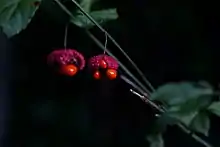 | |
| Euonymus americanus fruit capsule and fruit | |
| Scientific classification | |
| Kingdom: | Plantae |
| Clade: | Tracheophytes |
| Clade: | Angiosperms |
| Clade: | Eudicots |
| Clade: | Rosids |
| Order: | Celastrales |
| Family: | Celastraceae |
| Genus: | Euonymus |
| Species: | E. americanus |
| Binomial name | |
| Euonymus americanus | |
This is a deciduous shrub growing up to 2 metres (6 ft 7 in) tall. The oppositely arranged leaves are leathery or papery in texture and measure up to 10 cm (3.9 in) long. Flowers are borne in the leaf axils on peduncles up to 2.2 cm (0.87 in) long. The yellow-green sepals are 1 or 2 cm (0.39 or 0.79 in) long and the greenish or reddish petals above are smaller. The fruit capsule is about 1.5 cm (0.59 in) wide with a red warty or spiny covering. The capsule splits into five sections, revealing seeds covered in bright red arils.[4]
The seeds are dispersed by animals.[4] Deer have been known to graze on this plant and seem to love the tender leaves and stems. Humans should take the red color of the seeds as a warning; they are known to be a strong laxative and cause severe diarrhea. In fact, this genus of plants in general is considered poisonous to humans.[5]
Description
Euonymus americanus is a deciduous shrub that grows low to the ground only reaching up to 2-3.5 m high.[6] Euonymus americanus grows white and green flowers that produce orange and red colored fruits.[7] The white flowers on Euonymus americanus start to form unique pink fruit capsules that look somewhat like the common strawberry will start to open in the fall months revealing large orange seeds.[8]
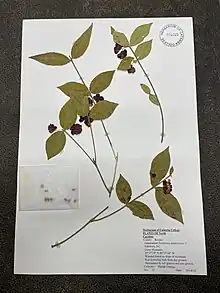
Taxonomy
Euonymus americanus is one out of 1,300 species of the plants within the Celastraceae family[9] which is also known as the bittersweet family.[10] Euonymus americanus L. was described by Carl Linnaeus in 1753.[11] Some common names of Euonymus americanus include hearts-bustin'-with-love, bursting-heart, and the american strawberry bush.[12] Euonymus americanus has three subspecies including Euonymus americanus var. angustifolius, Euonymus americanus var. obvatus and Euonymus americanus var. sarmentosus.[13] The American Strawberry Bush also has eight different synonyms including Euonymus alternifolius and Euonymus angustifolius.[13]
Distribution and habitat
Although Euonymus americanus L. is one of the 1,300 species members in the Celastraceae family, it is the only bittersweet family shrub that is found exclusively in the United States.[14] The American strawberry bush is found in wetland areas such as margins of swamps, shaded stream banks, and sloped wetlands.[11] However, though it resides in moist areas it is not a flood tolerant species; therefore, only being able to grow in moderately saturated soils. The shrub can grow in shaded conditions.[11]
Traditional uses
Native Americans used the roots of the Euonymus americanus to make a tea that would aid in uterine prolapse, vomiting of blood, stomach aches, malaria, liver congestion, constipation, and urinary tract infections.[15] The bark of the shrub was also used in aiding dandruff control when the bark was turned into a powder like substance.[15] Additionally, the seed of the American strawberry bush can be used as a strong laxative.[15]
Conservation
The American strawberry bush is common in most of its range. However, Euonymus americanus is listed as endangered in the state of New York.[7]
Wildlife uses
Euonymus americanus has vibrant fruits and foliage during the early autumn season which can attract white-tailed deer and rabbit herbivores[16] The white-tailed deer also eats the twigs of the American strawberry bush.[17] The bright orange-red aril that covers the seed provides a source of fat and sugar to songbirds, small mammals, and wild turkeys.[18] The seeds of Euonymus americanus are dispersed by animals like birds and deer.[19] It has been marked as a pollinator plant, supporting and attracting bees, beetles, flies, and ants. [20]
Diseases and insect pests
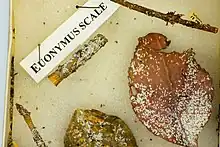
Unaspis euonymi, also known as euonymus scale, is the most common pest found on Euonymus.[21] Scales have no legs that are visible to the naked eye and are small, motionless insects that vary in appearance depending on the sex and age of the scale.[21] Euonymus scales pierce the leaf or stem of the Euonymus plant and feed on the sap.[21] The initial indication of an infestation of euonymus scale on the plant is the development of yellow spots on the leaves.[21] A heavy infestation can be seen as clusters of white on the top and bottom of the leaf as well as the stems.[21] These heavy infestations can cause the branches or even the entire plant to die.[21]
Some common diseases that are developed in Euonymus include powdery mildew, anthracnose, cercospora leaf spot, scab, and crown gall.[22]
Euonymus is host to webworm larvae of the American ermine moth Yponomeuta multipunctella.[23]
Gallery
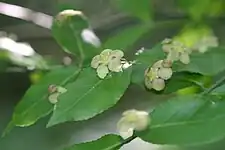 Flowers
Flowers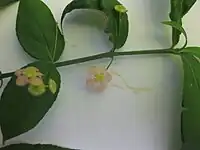 Leaves
Leaves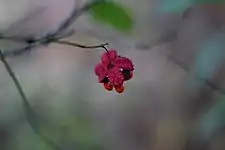 Fruit capsule
Fruit capsule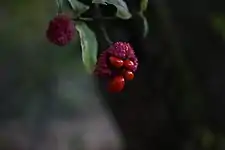 Underview of fruit and fruit capsule
Underview of fruit and fruit capsule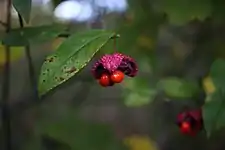 Fruit body with leaf
Fruit body with leaf
References
- NatureServe (1 September 2023). "Euonymus americanus". NatureServe Network Biodiversity Location Data accessed through NatureServe Explorer. Arlington, Virginia: NatureServe. Retrieved 30 September 2023.
- Euonymus americanus. USDA PLANTS.
- "Euonymus americanus". Germplasm Resources Information Network. Agricultural Research Service, United States Department of Agriculture. Retrieved 14 January 2018.
- Ma, J. and G. Moore. Euonymus americanus L. International Institute of Tropical Forestry (IITF). United States Department of Agriculture (USDA) Forest Service.
- "December Plant of the Month: Euonymus americanus". utgardens.tennessee.edu. Retrieved 2015-10-09.
- Francis, John K. (2004). "Wildland shrubs of the United States and its territories: Thamnic descriptions, Volume 1". San Juan, PR. doi:10.2737/iitf-gtr-26.
{{cite journal}}: Cite journal requires|journal=(help) - "New York City EcoFlora » New York Botanical Garden". New York Botanical Garden. Retrieved 2021-11-12.
- "Gardening for a Drought: North Carolina Native Plants to the Rescue - North Carolina Botanical Garden". Retrieved 2021-11-15.
- "Euonymus americanus | International Plant Names Index". www.ipni.org. Retrieved 2021-11-15.
- "Celastraceae | plant family | Britannica". www.britannica.com. Retrieved 2021-11-12.
- "Euonymus species Strawberry bush", A Guide to Poisonous House and Garden Plants, Teton NewMedia, pp. 165–166, 2007-01-01, doi:10.1201/b16160-46, ISBN 9780429163104, retrieved 2021-10-13
- "USDA Plants Database". plants.sc.egov.usda.gov. Retrieved 2021-11-12.
- "Euonymus americanus L. — The Plant List". www.theplantlist.org. Retrieved 2021-11-12.
- Howard, Gary T.; Elliott, Larry P. (January 1988). "Effects of Cellulolytic Ruminal Bacteria and of Cell Extracts on Germination of Euonymus americanus L. Seeds". Applied and Environmental Microbiology. 54 (1): 218–224. Bibcode:1988ApEnM..54..218H. doi:10.1128/aem.54.1.218-224.1988. ISSN 0099-2240. PMC 202424. PMID 16347528.
- "Alaska MCH facts--Women's health: Knowledge of folic acid benefits". PsycEXTRA Dataset. 2002. doi:10.1037/e433642008-001. Retrieved 2021-10-18.
- "Five Facts: Hearts-a-bustin' in Florida". Florida Museum. 2019-02-13. Retrieved 2021-11-12.
- "Euonymus americanus (Hearts A'busting, Strawberry Bush) | North Carolina Extension Gardener Plant Toolbox". plants.ces.ncsu.edu. Retrieved 2021-11-15.
- "Five Facts: Hearts-a-bustin' in Florida". Florida Museum. 2019-02-13. Retrieved 2021-11-15.
- "Euonymus americanus". Jersey-Friendly Yards. Retrieved 2021-11-26.
- "Planting Guides" (PDF). Pollinator.org. Retrieved 2022-01-29.
- Feb 26, Factsheet | HGIC 2054 | Updated; Download, 2021 | Print |. "Euonymus Diseases & Insect Pests". Home & Garden Information Center | Clemson University, South Carolina. Retrieved 2021-11-15.
- "Diseases of the Euonymus Shrub". Garden Guides. Retrieved 2021-11-15.
- "Yponomeuta multipunctella Clemens, 1860 - American Ermine Moth". Moths of North Carolina. North Carolina Biodiversity Project. Retrieved 5 July 2022.
